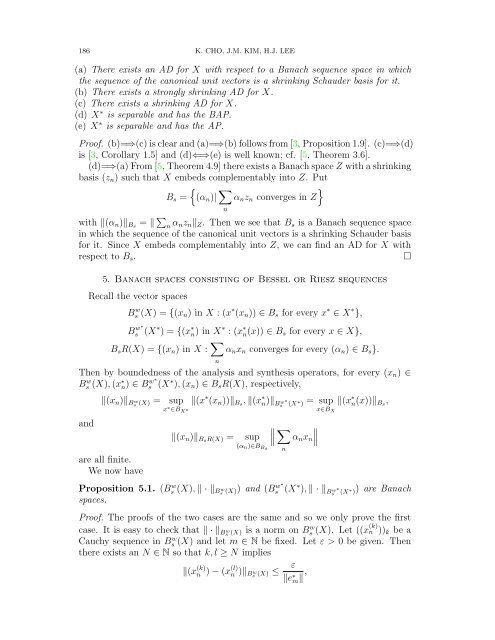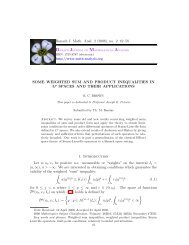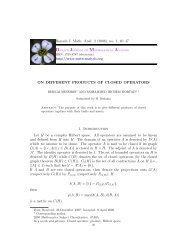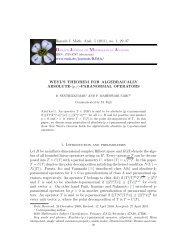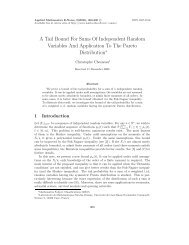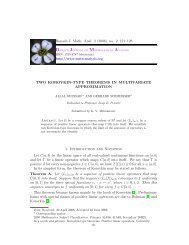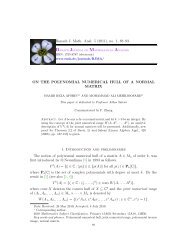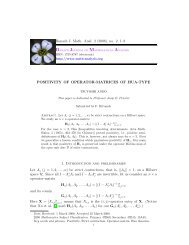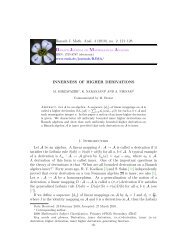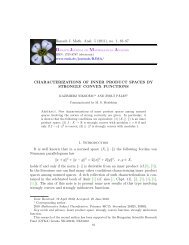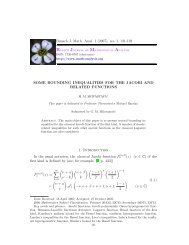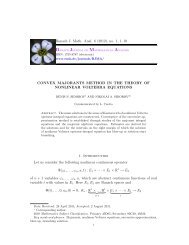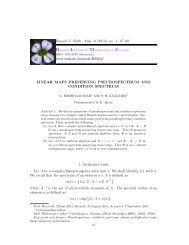Frames and Riesz bases for Banach spaces, and Banach spaces of ...
Frames and Riesz bases for Banach spaces, and Banach spaces of ...
Frames and Riesz bases for Banach spaces, and Banach spaces of ...
- No tags were found...
Create successful ePaper yourself
Turn your PDF publications into a flip-book with our unique Google optimized e-Paper software.
186 K. CHO, J.M. KIM, H.J. LEE(a) There exists an AD <strong>for</strong> X with respect to a <strong>Banach</strong> sequence space in whichthe sequence <strong>of</strong> the canonical unit vectors is a shrinking Schauder basis <strong>for</strong> it.(b) There exists a strongly shrinking AD <strong>for</strong> X.(c) There exists a shrinking AD <strong>for</strong> X.(d) X ∗ is separable <strong>and</strong> has the BAP.(e) X ∗ is separable <strong>and</strong> has the AP.Pro<strong>of</strong>. (b)=⇒(c) is clear <strong>and</strong> (a)=⇒(b) follows from [3, Proposition 1.9]. (c)=⇒(d)is [3, Corollary 1.5] <strong>and</strong> (d)⇐⇒(e) is well known; cf. [5, Theorem 3.6].(d)=⇒(a) From [5, Theorem 4.9] there exists a <strong>Banach</strong> space Z with a shrinkingbasis (z n ) such that X embeds complementably into Z. Put{B s = (α n )| ∑ }α n z n converges in Znwith ‖(α n )‖ Bs = ‖ ∑ n α nz n ‖ Z . Then we see that B s is a <strong>Banach</strong> sequence spacein which the sequence <strong>of</strong> the canonical unit vectors is a shrinking Schauder basis<strong>for</strong> it. Since X embeds complementably into Z, we can find an AD <strong>for</strong> X withrespect to B s .□5. <strong>Banach</strong> <strong>spaces</strong> consisting <strong>of</strong> Bessel or <strong>Riesz</strong> sequencesRecall the vector <strong>spaces</strong>B w s (X) = {(x n ) in X : (x ∗ (x n )) ∈ B s <strong>for</strong> every x ∗ ∈ X ∗ },Bsw∗(X ∗ ) = {(x ∗ n) in X ∗ : (x ∗ n(x)) ∈ B s <strong>for</strong> every x ∈ X},B s R(X) = {(x n ) in X : ∑ α n x n converges <strong>for</strong> every (α n ) ∈ B s }.nThen by boundedness <strong>of</strong> the analysis <strong>and</strong> synthesis operators, <strong>for</strong> every (x n ) ∈Bs w (X), (x ∗ n) ∈ Bsw∗ (X ∗ ), (x n ) ∈ B s R(X), respectively,<strong>and</strong>‖(x n )‖ B w s (X) =are all finite.We now havesupx ∗ ∈B X ∗‖(x ∗ (x n ))‖ Bs , ‖(x ∗ n)‖ B ws∗ (X ∗ ) = sup ‖(x ∗ n(x))‖ Bs ,x∈B X∥ ∥∥ ∑ ∥ ∥∥‖(x n )‖ BsR(X) = sup α n x n(α n)∈B BsProposition 5.1. (Bs w (X), ‖ · ‖ B w s (X)) <strong>and</strong> (Bsw∗ (X ∗ ), ‖ · ‖ B w ∗s (X )) are <strong>Banach</strong>∗<strong>spaces</strong>.Pro<strong>of</strong>. The pro<strong>of</strong>s <strong>of</strong> the two cases are the same <strong>and</strong> so we only prove the firstcase. It is easy to check that ‖ · ‖ B w s (X) is a norm on Bs w (X). Let ((x (k)n )) k be aCauchy sequence in Bs w (X) <strong>and</strong> let m ∈ N be fixed. Let ε > 0 be given. Thenthere exists an N ∈ N so that k, l ≥ N implies‖(x (k)n ) − (x (l)n )‖ B w s (X) ≤ε‖e ∗ m‖ ,n


